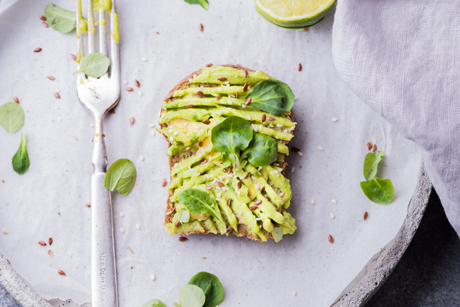
Canada’s first food guide came onto the scene in 1942, with a goal to prevent nutritional deficiencies in Canadians during wartime. The focus was on drinking ½ pint of milk, eating a daily serving of potatoes, tomatoes and meat or fish, and eating four to six slices of bread a day! Since then, the food guide has gone through many incarnations over the years, as new research and lobby groups changed the nutrition landscape.

The missing piece? Healthy fats. There is no mention of fat anywhere besides a small area that says “limit saturated fat”. We’re no longer in the era of the low-fat craze – quite the opposite, as research is continuously showing how important it is to consume good-for-you fats, so it’s unfortunate this entire macronutrient group is ignored. There are many different types of fats, some good and some bad, so it would have been beneficial to highlight the big difference between them. Read on for 10 important reasons why good fats are integral to a healthy, well-rounded diet:
1. Fat + Vegetables = Perfect Combo
You need fat to absorb vitamin A, D, E and K along with antioxidants, like lycopene and beta-carotene. That’s why it’s important to pair healthy versions (like extra virgin olive oil, sesame oil, olives or coconut oil) with your veggies. All of these nutrients have protective properties to promote longevity. So, bring on the healthy salad dressing!
2. Fats Are Essential
Fats like omega-3’s, found in walnuts, chia seeds, flax, salmon, mackerel and sardines, are essential, meaning the body can’t make them on its own, and they need to come from your diet. Omega-3 fatty acids play a role in disease prevention by lowering inflammation and slowing signs of aging.

3. Fats Protect Your DNA
Fats help build cell membranes. This is the outer layer of the cell that prevents bad substances from entering and protects internal DNA. DNA damage is what causes aging and age-related diseases.
4. Fats Help With Weight Loss
This one is pretty counter-intuitive, but fats that are composed of medium-chain fatty acids, like coconut oil and ghee, are immediately used for energy in the body; this increases metabolism and aids in weight loss.

5. Fats Provide Plenty of Energy
Fats have a lot of potential energy: one gram has double the calories as one gram of carbs (this is not a bad thing!). Some fat you eat gets converted into energy immediately, while others are stored and then burned for energy when the body needs it (for example, during exercise).
6. Fats Improve Brain Function
Fats are important for mental clarity, focus, cognitive function and enhancing memory. They also surround nerve fibres in the brain, which helps speed up brain communication and impulses.

7. Fats Help Delay Aging
A study found that a high fat diet can postpone signs of aging in the brain and may prevent age-related cognitive decline and reduce the risk of Alzheimer’s disease.
8. Fats Help Fight Disease
Recent research found that when diets high in good-quality fats, like butter and cold-pressed oils, are combined with low sugar and low processed foods, disease risks are reversed: good cholesterol (HDL) increases, blood pressure improves, circulating triglycerides are reduced and insulin and blood sugar levels decrease.

9. Fats Insulate and Protect
Fat controls the internal temperature of the body, ensuring you’re warmer in the winter. It also cushions vital organs like your kidneys, heart and the brain, protecting them from injury.
10. Fat is Needed for Healthy Skin
Skin cells are surrounded by layers of fat that help skin look plump and hydrated. Omega 3’s play a big role in providing the building blocks for healthy skin and lowering inflammation.

Despite healthy fats not being prominently featured in the new food guide, plenty of other promising updates were made. Here are the top 7 positive changes that should be celebrated:
● The food guide is now a plate (goodbye, rainbow cartoon food images!), which provides a great visual to understand what your plate and portion sizes should resemble.
● Veggies and fruits take up half the plate (a big win!) and they highlight a variety of rainbow coloured produce, from broccoli and berries to cabbage, spinach and peas.
● Meat and alternatives is now simply “protein”, showing that protein comes in many shapes and sizes and not just through animal products.
● Milk and alternatives was removed, which is now encompassed within protein, as there are many Canadians who can’t tolerate dairy.
● Grain products have become “whole grains”, focusing on those that are fibre-rich rather than refined.
● Water is highlighted as the beverage of choice.
● The guide focuses on eating habits: being mindful when you dine, deeply enjoying your food, sharing meals with others and cooking more often.
Photos courtesy of Getty Images and Unsplash
